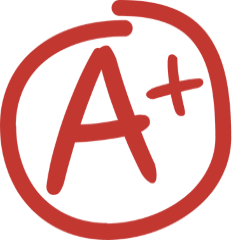Probability Concepts and Applications
Week One Homework Assignment - Statistics and Probability
The head of the chemistry department at a local university has tasked a student teaching assistant to prepare a variety of statistics pertaining to the final course grades earned by students who have completed the university’s CHEM 103 course during the past ten years. These statistics will be used as a basis for predicting the potential performance of future students who enroll in the course. A total of 1,125 students have completed the course during the past ten years. Rather than trying to have the teaching assistant collect and analyze data for all 1,125 students, the department head has agreed to allow the teaching assistant to prepare the necessary statistics using a random sample consisting of 25 students who completed the course during the past ten years. The following table summarizes the final course grades earned by the 25 randomly selected students.
|
Student No. |
Course Grade |
|
1 |
83.17 |
|
2 |
82.31 |
|
3 |
90.18 |
|
4 |
93.63 |
|
5 |
90.14 |
|
6 |
96.06 |
|
7 |
83.75 |
|
8 |
85.17 |
|
9 |
86.67 |
|
10 |
93.81 |
|
11 |
83.11 |
|
12 |
82.16 |
|
13 |
89.48 |
|
14 |
86.76 |
|
15 |
83.76 |
|
16 |
86.89 |
|
17 |
88.57 |
|
18 |
96.93 |
|
19 |
86.48 |
|
20 |
95.82 |
|
21 |
92.32 |
|
22 |
78.70 |
|
23 |
92.67 |
|
24 |
74.56 |
|
25 |
78.48 |
For the purposes of this assignment, assume that: (1) the sample consisting of 25 students is truly representative of the population of 1,125 students from which it was drawn; and (2) the 1,125 students who have completed the course during the past ten years constitute a truly representative sample of all future students who will eventually enroll in the course. Based upon these assumptions, use the sample data provided in the preceding table to answer the following questions.
- What is the predicted range for the mean grade for an average future student enrolling in the
- 27.65
- 22.37
- 19.87
- 34.68
- What is the predicted mean grade for an average future student enrolling in the CHEM 103 course?
- 76.31
- 83.26
- 87.26
- 90.89
- What is the predicted median grade for an average future student enrolling in the CHEM 103 course?
- 86.76
- 91.94
- 79.16
- 90.91
- What is the predicted standard error of the mean grade for an average future student enrolling in the CHEM 103 course?
- 1.58
- 2.29
- 2.11
- 1.18
- Assuming the level of confidence for the interval estimate is not specified, what is the predicted interval estimate for the mean grade for an average future student enrolling in the CHEM 103 course?
- 86.12 – 89.67
- 88.44 – 91.35
- 86.09 – 88.44
- 89.65 – 92.23
- Assuming that a 99% level of confidence for the interval estimate is desired, what is the predicted interval estimate for the mean grade for an average future student enrolling in the CHEM 103 course?
- 84.23 – 90.30
- 85.45 – 90.87
- 78.41 – 89.34
- 83.29 – 90.15
- What is the predicted variance for the grades for average future students enrolling in the CHEM 103 course?
- 48.23
- 79.68
- 52.75
- 34.68
- What is the predicted standard deviation for the grades for average future students enrolling in the CHEM 103 course?
- 7.43
- 5.89
- 4.31
- 6.93
Using the previously provided sample data for the final course grades earned by the 25 randomly selected students, determine the frequency, relative frequency and cumulative frequency for each of the following eleven grade classes.
|
Grade Classes |
|---|
|
0.00-10.00 |
|
10.00-20.00 |
|
20.00-30.00 |
|
30.00-40.00 |
|
40.00-50.00 |
|
50.00-60.00 |
|
60.00-70.00 |
|
70.00-80.00 |
|
80.00-90.00 |
|
90.00-100.00 |
|
100.00 or more |
- Assuming that student grades would theoretically be symmetrically distributed around the 70.00 – 80.00 grade class, does the histogram indicate that the distribution of actual student grades is skewed (either positively skewed or negatively skewed)?
- Yes
- No
- Which grade class evidences the highest frequency of actual student grades?
- 60.00 – 70.00
- 80.00 – 90.00
- 90.00 – 100.00
- 70.00 – 80.00
- What is the relative frequency for the 70.00 – 80.00 grade class?
- 64.00%
- 12.00%
- 100.00%
- 0.00%
- What is the cumulative frequency for the 80.00 – 90.00 grade class?
- 100.00%
- 12.00%
- 64.00%
- 0.00%
The following table summarizes the grades for ten group projects for two groups of high school students.
|
Project No. |
Group 1 Grades |
Group 2 Grades |
|
1 |
96.11 |
99.22 |
|
2 |
87.65 |
96.44 |
|
3 |
84.35 |
73.61 |
|
4 |
92.01 |
84.32 |
|
5 |
98.69 |
68.51 |
|
6 |
83.65 |
95.58 |
|
7 |
78.35 |
96.97 |
|
8 |
88.89 |
77.49 |
|
9 |
94.94 |
89.35 |
|
10 |
77.22 |
86.99 |
Use the information in the preceding table to answer the following question.
- What is the mean project grade for Group 1?
- 88.19
- 86.85
- 89.19
- 85.89
- What is the mean project grade for Group 2?
- 85.29
- 86.85
- 84.19
- 88.89
- What is the standard deviation for the mean project grade for Group 1?
- 5.69
- 7.35
- 6.43
- 8.28
- What is the standard deviation for the mean project grade for Group 2?
- 6.69
- 8.24
- 9.43
- 10.73
- Which group of students exhibits the least degree of central tendency about the mean value for their project grades?
- Group 1
- Group 2
A standard deck of playing cards consists of fifty-two cards. The cards in each deck consist of four suits, namely spades (♠), clubs (♣), diamonds (♦) and hearts (♥). Each suit consists of thirteen cards, namely ace, king, queen, jack, 10, 9, 8, 7, 6, 5, 4, 3, and 2. In the game of poker, a royal flush consists of the ace, king, queen, jack, and 10 of the same suit (e.g., ace of spades, king of spades, queen of spades, jack of spades and 10 of spades).
- What is the probability of randomly selecting five cards from a randomly shuffled deck of playing cards that constitute a royal flush, assuming the order in which the cards are selected is irrelevant (i.e., not important) and the suit is irrelevant (i.e., not important)?
- 1.5 x 10-6
- 3.6 x 10-7
- 7.1 x 10-8
- 1.5 x 10-8
- What is the probability of randomly selecting five cards from a randomly shuffled deck of playing cards that constitute a royal flush, assuming the cards must be selected in a specific order, namely ace, king, queen, jack and 10, and the suit is irrelevant (i.e., not important)?
- 1.3 x 10-6
- 2.6 x 10-6
- 1.3 x 10-8
- 7.1 x 10-8
50 students in two sections of a college Physics 101 course recently took a mid-term exam. 13 students earned an A, 10 students earned a B, 8 students earned a C, 9 students earned a D and 10 students earned an F on the exam. The students were queried regarding the number of hours they had devoted to studying for the exam. 12 of the students who earned an A, 8 of the students who earned a B, 6 of the students who earned a C, 2 of the students who earned a D, and 1 of the students who earned an F reported that they had devoted more than 8 hours to studying for the exam. The remaining students reported that they had devoted no more than 8 hours to studying for the exam.
- What is the probability of a randomly selected student having earned an A on the exam?
- 0.15
- 0.26
- 0.32
- 0.07
- What is the probability of a randomly selected student having earned an F on the exam?
- 0.20
- 0.27
- 0.36
- 0.17
- What is the probability of a randomly selected student having devoted no more than 8 hours to studying for the exam?
- 0.51
- 0.34
- 0.42
- 0.29
- What is the probability of a randomly selected student having earned an A on the exam given they devoted no more than 8 hours to studying for the exam?
- 0.12
- 0.21
- 0.17
- 0.05
- What is the probability of a randomly selected student having earned an F on the exam given they devoted more than 8 hours to studying for the exam?
- 0.12
- 0.03
- 0.09
- 0.17
- What is the probability of a randomly selected student having earned an A or a B on the exam given they devoted more than 8 hours to studying for the exam?
- 0.57
- 0.47
- 0.69
- 0.76
Probability Concepts and Applications/Quantative analysis Solutions
Attached please ...




Probability Concepts and Applications/Quantative analysis Solutions
Solutions #1.Predicted range=Highest-lowest 96.93-74.56=22.37 #2.mean=∑x/n =2181.58/25 =87.26 #3.median is the middle score after arranging in ascending or descending order 86.76 #4. Standard error=SD/√N SD=√(∑x^2-nẍ^2 ) Where ẍ is the mean n=25 = √(191204.1-25*〖87.26〗^2 ) =5.8893 SO S.E=5.8893/√25 =1.18 #5. C.I= Lower limit=mean-standard error=87.26-1.18=86.08 Upper limit=mean +standard error=87.26+1.18=88.44 Hence C.I = 86.09-88.44 #6. Lower limit = M - Z.99σM Upper limit = M + Z.99σM Lower limit = 87.26 - (2.33)(1.18)= 84.5106 Upper limit = 87.26 + (2.33)(1.18)= 90.0094 Where 2.33 is the table value for 99% level of confidence.( Z.99) Hence C.I=84.23 – 90.30 ERROR DUE TO ROUNDING OFF #7. VARIANCE=√(1/N∑x^2-nẍ^2 ) = 191204.1-25*〖87.26〗^2 =34.68 #8 STANDARD DEVIATION=√Variance =√34.68 =5.89 Grade Classes Frequency Relative Freq. =Frequency/n Cumulative Freq. =sum of relative Freq. 0.00-10.00 0 0/25=0 0 10.00-20.00 0 0/25=0 0 20.00-30.00 0 0/25=0 0 30.00-40.00 0 0/25=0 0 40.00-50.00 0 0/25=0 0 50.00-60.00 0 0/25=0 0 60.00-70.00 0 0/25=0 0 70.00-80.00 3 3/25=0.12 0.12 80.00-90.00 13 13/25=0.52 0.12+0.5...




Probability Concepts and Applications/Quantative analysis Solutions
thanks for buying this ...





Goodjob
Senior JournalistSell Your Solution Report Solution Support Center




A+ - Thank you!
Thanks for the positive feedback!